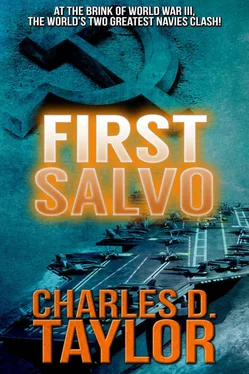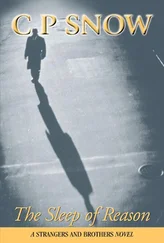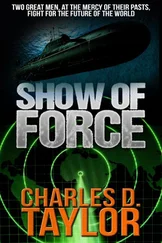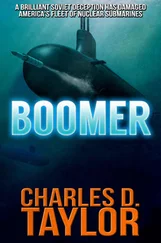“Hope you don’t mind, Captain.”
“Not at all. I hope you’ll let everyone know right now it’s a real honor for me.”
It felt good. There was something special about commanding a ship — nothing like it in the world. He wanted Yorktown to be his for a long time.
The disposition of the battle group spread before him on another board. Surrounding Kennedy were the nuclear cruiser Arkansas, two double-ended guided missile cruisers, Yarnell and Dale , and the two Spruance-class destroyers, Radford and Stump. Wendell Nelson was to the south, toward the Gulf of Sidra, with seven more Spruance destroyers. A combined NATO force, made up of ships from Italy, France, and England, covered the northern flank. The small Italian carrier Garibaldi had reinforced this unit for antisubmarine purposes. To the east were the picket ships, groups of two to four units whose responsibility was both early warning and first-line harassment of the superior force aimed at the battle group.
The initial flight of Backfires had just now passed over the Black Sea into Bulgarian airspace — eight hundred miles distant. A small initial launch of new, untested missiles could be expected at a range of about five hundred miles, when they were over the Aegean Sea nearing Greece. Even then, the odds for these missiles were slim. But the idea was that the Backfires, already harassed by the Hawkeyes and Kennedy’ s fighters, would maintain a gradually increasing saturation effect.
The picket groups were not under fire themselves. Attack planes from Kharkov were combining with wolf packs to make life difficult for the easternmost group. The American losses would be heavy out there, but if they could limit the effectiveness of the Soviet attack subs, Kennedy ’s group had a fighting chance.
Carleton was tempted to step outside and enjoy the fresh air when his sandwiches came. Instead, he circulated around the darkened room, talking with the sailors, offering the support they were looking for. Then he slipped up to his cabin and penned a short note to his wife. It had become a habit whenever tension set in.
A change of clothes and a quick shave took only moments. To a crew as sharp as this one, a freshly pressed appearance would make all the difference in the world to morale. He also decided it would be a good idea to say a couple of words to them.
ABOARD U.S.S. JOHN HANCOCK, ONE HUNDRED MILES NORTHWEST OF BENGHAZI, LIBYA
Wendell Nelson convinced only the captain of Nicholson to call him Nellie; the others, though more at ease with him now, remained formal. He and Nicholson ’s captain were the last members of the old “black shoe” Navy, the ones who had come aboard during the Vietnam era. They had cut their teeth on remnants of the old steam-boiler fleet or chased through steaming jungles in riverboats. Though they were educated in the weapons of the eighties, they were inured to the older traditions.
Nelson was of their generation, but he was different; he was tight with this new admiral; he was tall and handsome and looked like a Moorish god in his whites; he made statements such as: “Be goddamn happy you have pilots who can fly helos off your fantail, because if you didn’t, the first sound you’d hear would be the detonation of a warhead fired by a submarine you didn’t know was there — and it would be the last thing you’d ever hear,” or, “Thank your lucky stars that you’ve been set loose from that battle group, because you don’t have enough protection on board to keep yourselves from being blown out of the water with that first salvo,” or, “You don’t have to think about the tactics I’m going to use — just follow directions. The computer will save your ass.”
They understood Wendell Nelson, grudgingly accepted his truisms, and would follow him. But that didn’t mean they had to like him. They accorded him the respect that Navy regs required and let it go at that. There was no time for comparing notes to see if they could present a united front. Each commanding officer was hidebound to his ship, responsible to his men, and would fight his ship to the maximum of his ability.
Nelson stretched, then patted his breast pocket and was reminded that he had run out of cigarettes. There was no way he could function without them, not now. He sent the bridge messenger to his cabin for three more packs. There was no telling how long it might be before he was able to get back down there himself.
There was a bit of the old Navy buried deep within Nelson. He preferred to spend as much time on the bridge as possible. Hell, he loved it. He could operate from there because his was a three-dimensional mind, one that could develop an absolute picture of his strategic environment. He could either picture John Hancock as the center and see the air, surface, and subsurface situation, or he could withdraw himself. He would place his mind in a remote location and develop a holographic image. In it, there was no ocean surface on which his ship sailed, nor a darkness that hid submarines. Rather, the surface was an invisible plane, the air above and the water below equally clear. He could visualize the whole picture; he was omniscient.
It was in that manner that he would function as a squadron commander, coordinating two divisions, each operating independently of the other. If the computer projections and Nelson’s mind functioned in concert, those two divisions would actually be sweeping the Soviet wolf packs in closer to each other than was judicious. Then he would destroy them — if they didn’t get him first.
Nelson thanked the messenger for the cigarettes, lit one immediately, and meandered over to the chart table. One of the quartermasters had set up a separate chart for him to insert latest-estimated-position reports. He erased the old locations, pinpointing the Soviet submarines that he was to take out.
He had no concern for those that were to the west of Malta or to the north in the Ionian Sea. They were covered by the NATO forces that Pratt had established. Garibaldi and her mixed-nationality escorts seemed in control up there. The submarines that Nelson targeted were proceeding from the east in advance of Kharkov and other Russian surface forces, or from the Gulf of Sidra to the south. The frigates were only a picket line, a stopgap measure to slow the advance from the east. Nelson estimated that as many as a dozen Soviet subs might penetrate that line after disposing of the frigates. With the eight that were coming from the south, it was indeed a formidable force. There were no friendly submarines to move ahead of him to counter them. The last order Pratt had given to his own submarine commander was to move eastward, placing himself between the Soviet carrier group and Kennedy ’s.
Nelson compared these subs to a pulling guard, leading the sweep around the end. Their mission was vitally important to the success of Soviet strategy. If the full force of that all-important first salvo was to achieve maximum effect, these submarines were the key. The Backfire bombers depended a great deal on them, the attacking surface forces depended on them, the entire strategy of achieving an initial blow that the Americans could not recover from depended on their success.
Pratt knew exactly how Nelson’s mind functioned, how the man responded to a threat. The Admiral envied Nelson’s ability to envision the threat by completely withdrawing and establishing that objective mental picture of his. He knew of no other man capable of succeeding in this particular case.
Nelson lit another cigarette from the butt of the one he had just finished. He sketched some more on his chart, then called his executive officer over. “This is where we’re going to chase them.” He pointed at an imaginary spot about a hundred miles north of Benghazi, Libya. “Have the communications officer prepare a message designating Nicholson ’s CO as northern division commander. I want him to move the remaining frigates gradually down in that direction. They’ll either chase the subs in their sector in his direction or draw them down there. I’ll take any help I can get.”
Читать дальше












